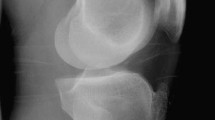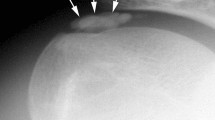Abstract
Purpose
The purpose of this study was to report characteristics and outcomes of surgical excision of symptomatic mature posttraumatic myositis ossificans in adult athletes. The hypothesis was that surgical excision of the ossified mass in these circumstances can effectively relief symptoms and result in return to high-level sports with minimal postoperative complications.
Methods
All operations involving excision of posttraumatic heterotopic ossifications performed between 1987 and 2015 were reviewed. Included cases had isolated excision of posttraumatic myositis ossificans, whereas excluded cases had: (1) concomitant reattachment of tendon to bone; (2) chronic overuse injuries which preceded the development of the heterotopic mass or large calcifications which were excised from tendon-to-bone insertions; and (3) excision of heterotopic ossification from a ligament, capsule, or tendon insertion following avulsion injury without tendon-to-bone repair. After surgery, return to sports was allowed at 4–6 weeks.
Results
Of 57 athletes undergoing excision of heterotopic ossifications, 32 were eligible as isolated excision of posttraumatic myositis ossificans. Twenty-four (75%) were ice hockey or soccer players. Median age was 23 years. Prior to surgery, patients were unable to continue their sports. At surgery, the ossification was excised from a thigh muscle in 27 (84%) cases. Median follow-up was 2 years (range 1–20 years). Outcome was Good/Excellent in 26 (81%) patients, corresponding to return to preinjury sports with minimal symptoms at sports activities. Preinjury Tegner activity level was resumed after surgery in 30 of 32 (94%) athletes, of whom 28 (94%) were involved in high-level sports corresponding to Tegner levels 8–10. No postoperative complications were recorded other than minimal insensitive areas at the periphery of skin incisions.
Conclusion
In high-level athletes who present chronic disabling mature posttraumatic myositis ossificans that interferes with their sports career, surgical excision of the heterotopic mass results in effective clinical improvement with return to sports and minimal postoperative risks.
Level of evidence
Case series, Level IV.



Similar content being viewed by others
References
Ardern CL, Glasgow P, Schneiders A, Witvrouw E, Clarsen B, Cools A, Gojanovic B, Griffin S, Khan KM, Moksnes H, Mutch SA, Phillips N, Reurink G, Sadler R, Silbernagel KG, Thorborg K, Wangensteen A, Wilk KE, Bizzini M (2016) 2016 Consensus statement on return to sports from the First World Congress in Sports Physical Therapy, Bern. Br J Sports Med 50:853–864
Bressler EL, Marn CS, Gore RM, Hendrix RW (1987) Evaluation of ectopic bone by CT. AJR Am J Roentgenol 148:931–935
Buselli P, Coco V, Notarnicola A, Messina S, Saggini R, Tafuri S, Moretti L, Moretti B (2010) Shock waves in the treatment of post-traumatic myositis ossificans. Ultrasound Med Biol 36:397–409
Daly PJ, Sim FH, Simonet WT (1990) Ice hockey injuries. A review. Sports Med 10:122–131
Delos D, Maak TG, Rodeo SA (2013) Muscle injuries in athletes: enhancing recovery through scientific understanding and novel therapies. Sports Health 5:346–352
Garland DE (1991) A clinical perspective on common forms of acquired heterotopic ossification. Clin Orthop Relat Res 263:13–29
Goyal K, Pettis CR, Bancroft AE, Wasyliw CW, Scherer KF (2015) Myositis ossificans in the thigh of a lacrosse player. Orthopedics 38:515–518
Guan Z, Wilson TJ, Jacobson JA, Hollon TC, Yang LJ (2016) Delayed sciatic nerve injury resulting from myositis ossificans traumatica. PM&R 8:484–487
Hetsroni I, Dela Torre K, Duke G, Lyman S, Kelly BT (2013) Sex-differences of hip morphology in young adults with hip pain and labral tears. Arthroscopy 29:54–63
Hetsroni I, Larson CM, Dela Torre K, Zbeda RM, Magennis K, Kelly BT (2012) Anterior inferior iliac spine deformity as an extra-articular source for hip impingement: a series of 10 patients treated with arthroscopic decompression. Arthroscopy 28:1644–1653
Hewett TE, Myer GD, Ford KR, Heidt RS, Colosimo AJ, McLean SG, van der Bogert AJ, Paterno MV, Succop P (2005) Biomechanical measures of neuromuscular control and valgus loading of the knee predict anterior cruciate ligament injury risk in female athletes. A prospective study. Am J Sports Med 33:492–501
Jackson DW, Feagin JA (1973) Quadriceps contusions in young athletes: relation of severity of injury to treatment and prognosis. J Bone Joint Surg Am 55:95–105
King JB (1998) Post-traumatic ectopic calcification in the muscles of athletes: a review. Br J Sports Med 32:287–290
Li J, Zhu L, Hu Y, Liu M (2000) Clinical analysis of 26 cases of myositis ossificans circumscripta. Chin J Traumatol 3:124–125
MacCormick L, Best TM, Flanigan DC (2014) Are there differences in Ice Hockey injuries between sexes? A systematic review. Orthop J Sports Med 2:2325967113518181. doi:10.1177/2325967113518181
Miller AE, Davis BA, Beckley OA (2006) Bilateral and recurrent myositis ossificans in an athlete: a case report and review of treatment options. Arch Phys Med Rehabil 87:286–290
Olsson O, Isacsson A, Englund M, Frobell RB (2016) Epidemiology of intra- and peri-articular structural injuries in traumatic knee joint hemarthrosis—data from 1145 consecutive knees with subacute MRI. Osteoarthr Cartil. doi:10.1016/j.joca.2016.06.006
Orava S, Hetsroni I, Marom N, Mann G, Sarimo J, Ben-Zvi O, Lempainen L (2015) Surgical excision of post-traumatic ossifications at the proximal hamstrings in young athletes: technique and outcomes. Am J Sports Med 43:1331–1336
Ryan JB, Wheeler JH, Hopkinson WJ, Arciero RA, Kolakowski KR (1991) Quadriceps contusions. West Point update. Am J Sports Med 19:299–304
Salga M, Jourdan C, Durand MC, Hangard C, Denormandie P, Carlier RY, Genet F (2015) Sciatic nerve compression by neurogenic heterotopic ossification: use of CT to determine surgical indications. Skeletal Radiol 44:233–240
Simon T, Guillodo Y, Madouas G, Saraux A (2016) Myositis ossificans traumatica (circumscripta) and return to sport: a retrospective series of 19 cases. Joint Bone Spine 83:416–420
Srikanth IM, Vishal A, Kiran KR (2015) Myositis ossificans of rectus femoris: a rare case report. J Orthop Case Rep 5:92–94
Tegner Y, Lysholm J (1985) Rating systems in the evaluation of knee ligament injuries. Clin Orthop Relat Res 198:43–49
Walczak BE, Johnson CN, Howe BM (2015) Myositis ossificans. J Am Acad Orthop Surg 23:612–622
Author information
Authors and Affiliations
Corresponding author
Ethics declarations
Conflict of interest
All authors declare that they do not have any conflict of interests related to this article.
Funding
This study did not receive any specific grant or any funding from any funding agency.
Ethical approval
The local hospital ethics committee (Hospital NEO, Turku, Finland) approved the study protocol on 16 September 2016. It includes only retrospective data obtained from hospital databases and did not require any patient to sign informed consent form.
Rights and permissions
About this article
Cite this article
Orava, S., Sinikumpu, JJ., Sarimo, J. et al. Surgical excision of symptomatic mature posttraumatic myositis ossificans: characteristics and outcomes in 32 athletes. Knee Surg Sports Traumatol Arthrosc 25, 3961–3968 (2017). https://doi.org/10.1007/s00167-017-4667-7
Received:
Accepted:
Published:
Issue Date:
DOI: https://doi.org/10.1007/s00167-017-4667-7




